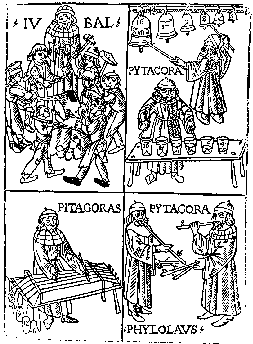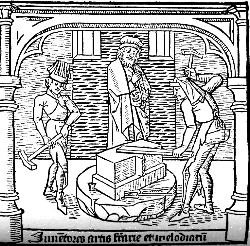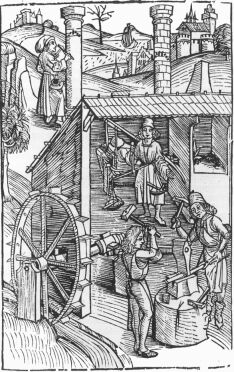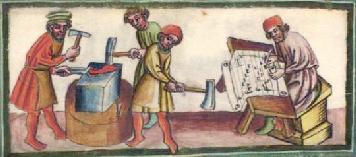
Gl. Kgl. Saml. 79 2o, 55 recto, Germany ca. 1430 (detail)
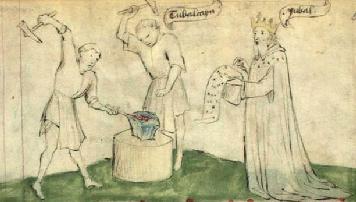
Gl. Kgl. Saml. 80 2o, 47 verso, Germany 1400-50 (detail)
|
A search on the Internet early december 2000, directed my attention to the site of the Danish Royal
Library in Copenhagen that has scanned a number of their manuscripts and put them on
line. In the old royal collection there are two beautifully illustrated editions of the Speculum Humanae Salvationis
that both are different from the edition I already
knew.
The pictures from these two editions are of a simpler design, are more
explicit and the lower one even uses name tags which together makes them a lot
easier to read than the first two Jubal pictures.
On the right side of both pictures you can see Jubal actively writing music
(compared to the first two pictures where Jubal is just 'observing'), while
Tubalcain is forging (upper picture on the left, lower picture in the middle)
with one or two assistants. The upper picture shows a clear difference in the
size of the various hammers being used, while in the lower picture the size of
both hammers seems to be equal. This might indicate that the artisan who made
the lower picture was not aware of the relevance of the size of the hammers.
Another feature of the lower picture that strikes me as odd is the royal crown
and robe of Jubal. There is no record as far as I know of Jubal being a king.
There is however another royal figure looming in the background: Pheidon king
of Argos. All this of course is still tentative at most:)
|
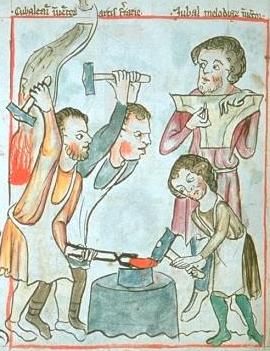
Cod. Nr. S.N. 2612, 25 verso, Austria 1350-1400 (detail)
| After a second sweep along the internet, february 26, 2001, I discovered a picture from a late 14th century
Speculum edition that belongs to the
Österreichische Nationalbibliothek.
This one is even easier to interpret than the Danish pictures: It has two explanatory texts at the top
(Tubalcain inventor artis ferrarie; Jubal melodiae(?) inventor which agrees with the
later Utrecht edition) and Jubal carries (plays?) a cythara.
Furthermore at the left a fire for heating the (red hot) iron is visible,
which is missing from the later Danish pictures (they only show a piece of red hot metal).
Again there is little evidence that the weight of the hammers is of importance.
Notice however the two assistants using both hands, whereas the bearded Tubalcain only uses his right hand.
This might indicate a difference either in weight (of the hammers) or in strength (of the men).
My guess is that all these pictures are based on Petrus Comestor's story of
Jubal listening to the beating (by Tubalcain and others) with hammers on an anvil.
|
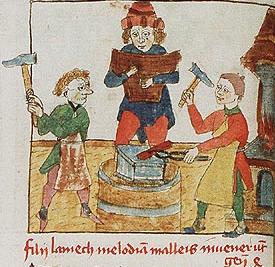
The Hague, MMW, 10 B34, 23v. 1450 (detail)
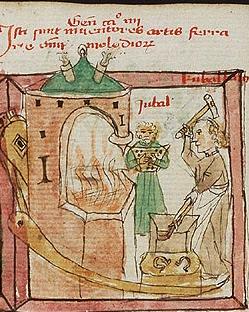
The Hague, MMW, 10 C23, 26v. 1400-1500 (detail)
| A visit march 7, 2002 to the recently opened mediaeval manuscript website of the National Library of the Netherlands & the
Meermanno Westranum museum, resulted in the next two Speculum images.
Both of these images follow the Austrian image closely with Jubal holding a cythara while watching Tubalcain (and assistent) pounding the hot iron. The presence of a fiery furnace is a new detail.
The first picture (filii Lamech melodia(m) malleis inveneru(n)t) seems to suggest a difference in the size of the hammers, the left being larger and being held with two hands.
Notice the realistic details in the second, more sketch like picture (Isti sunt inventores artis ferra ?? ??? melodias) like the horseshoes next to the anvil and the bellows. Also notice that the right arm of TubalCain was somewhat reduced.
An erased hammer is visible between the actual hammer and the names Jubal and Tubalkain |
